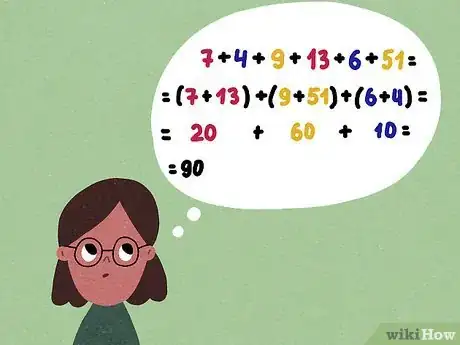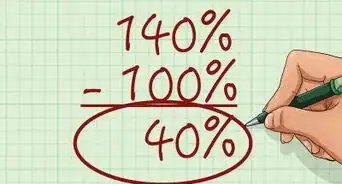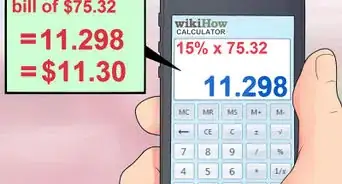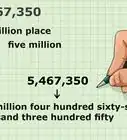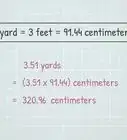This article was co-authored by Daron Cam. Daron Cam is an Academic Tutor and the Founder of Bay Area Tutors, Inc., a San Francisco Bay Area-based tutoring service that provides tutoring in mathematics, science, and overall academic confidence building. Daron has over eight years of teaching math in classrooms and over nine years of one-on-one tutoring experience. He teaches all levels of math including calculus, pre-algebra, algebra I, geometry, and SAT/ACT math prep. Daron holds a BA from the University of California, Berkeley and a math teaching credential from St. Mary's College.
There are 8 references cited in this article, which can be found at the bottom of the page.
wikiHow marks an article as reader-approved once it receives enough positive feedback. In this case, 88% of readers who voted found the article helpful, earning it our reader-approved status.
This article has been viewed 189,058 times.
Eventually, you'll find yourself in a situation where you'll have to solve a math problem without a calculator. Trying to imagine a pen and paper in your head often doesn't help much. Fortunately there are faster and easier ways to do calculations in your head—and they often break down a problem in a way that makes more sense than what you learned in school. Whether you're a stressed-out student or a math wizard looking for even faster tricks, there's something for everyone to learn.
Steps
Community Q&A
-
QuestionI find it difficult to work out math in my mind because I have difficulty in working it out with a pen and paper and I still get the answers wrong. What can I do?
 TechnistCommunity AnswerYou need to get your basic addition and multiplication skills very solid. Multiplying big numbers can really be broken up into multiplying and adding smaller numbers. Keep working and practicing with the pen and paper until you understand the concept you're learning. Then slowly let it sink into your mind and apply it to other questions.
TechnistCommunity AnswerYou need to get your basic addition and multiplication skills very solid. Multiplying big numbers can really be broken up into multiplying and adding smaller numbers. Keep working and practicing with the pen and paper until you understand the concept you're learning. Then slowly let it sink into your mind and apply it to other questions. -
QuestionCan you explain 27 x 55 like above?
 TechnistCommunity AnswerYou can try to visualize it in your head first by separating it into 27(50 + 5). 27 x 50 = 1350 and 27 x 5 = 135. Add them together, 1350 + 135 = 1485. Now try to do it all in your head.
TechnistCommunity AnswerYou can try to visualize it in your head first by separating it into 27(50 + 5). 27 x 50 = 1350 and 27 x 5 = 135. Add them together, 1350 + 135 = 1485. Now try to do it all in your head. -
QuestionWhat would I do to not make dumb mistakes on important work like tests?
 Community AnswerRevise thoroughly before exam and try not to get stressed out. Make sure you have all the necessary materials before your test begins and put in effort. Read the questions very carefully before writing the answer. Try to manage time during the tests and re check it at least two or three times before handing it in.
Community AnswerRevise thoroughly before exam and try not to get stressed out. Make sure you have all the necessary materials before your test begins and put in effort. Read the questions very carefully before writing the answer. Try to manage time during the tests and re check it at least two or three times before handing it in.
References
- ↑ http://gizmodo.com/10-tips-to-improve-your-mental-math-ability-1792597814
- ↑ https://www.youtube.com/watch?v=Rgw9Ik5ZGaY
- ↑ https://www.youtube.com/watch?v=SV1dC1KAl_U
- ↑ https://www.youtube.com/watch?v=1JW9BA57aR8
- ↑ http://www.wired.co.uk/article/master-mental-maths
- ↑ https://www.youtube.com/watch?v=YCBTw8KAqkw
- ↑ https://www.scientificamerican.com/article/5-tips-faster-mental-multiplication/
- ↑ http://gizmodo.com/10-tips-to-improve-your-mental-math-ability-1792597814
- ↑ Daron Cam. Academic Tutor. Expert Interview. 29 May 2020.
About This Article
One way to improve your mental math skills is to memorize your multiplication and division tables, so you always have the answer to those problems instantly. If you have trouble memorizing the numbers, try creating your own flash cards with blank notecards and asking a friend to help you practice. Another good way to practice your mental math skills is to add up the prices of your items when you’re at the store, and check to make sure you added correctly once the cashier rings you up. You can also try downloading a mental math app like Luminosity to keep your math skills sharp. To learn how to visualize an equation in your head, read on!


